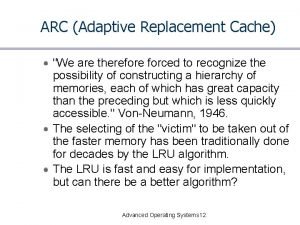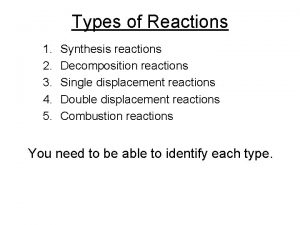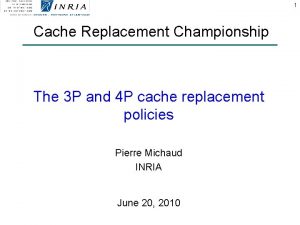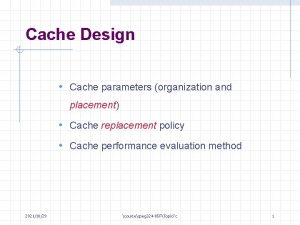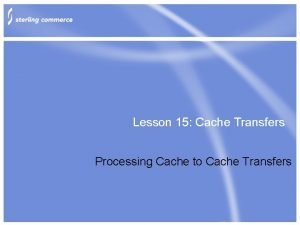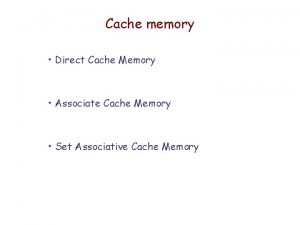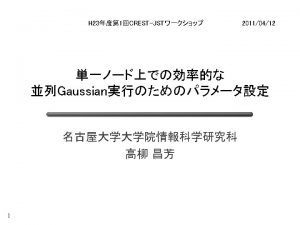1 Cache Replacement Championship The 3 P and













- Slides: 13

1 Cache Replacement Championship The 3 P and 4 P cache replacement policies Pierre Michaud INRIA June 20, 2010

2 Optimal replacement ? • Offline (we know the future) ➔ Belady • Online (we don’t know the future) ➔ problem without a solution – On random address sequences, all the online replacement policies perform equally on average The best online replacement policy does not exist

3 In practice… • We search a policy that performs well on as many applications as possible • We hope that our benchmarks are representative • But there is no guarantee that a replacement policy will always perform well

4 The DIP replacement policy • Qureshi et al. , ISCA 2007 • Key idea #1: bimodal insertion (BIP) – LRU behaves badly on cyclic accesses ➔ try to correct this – On a miss, insert block in MRU position only with probability E=1/32, otherwise leave it in LRU position • Key idea #2: set sampling – 32 LRU sets, 32 BIP sets, use best policy in the other sets • Beauty of DIP: just one counter !

5 Proposed policy • Incrementally derived from DIP – Start from a carefully tuned DIP • Based on CLOCK instead of LRU – needs less storage than LRU • Combines more than 2 different insertion policies – (new ? ) method for multi-policy selection

6 Carefully tuned DIP • Cache levels use unique line size ? ➔ OK – Otherwise a (small) filter would have been needed • Don’t update replacement info on writes – The fact that a block is evicted from a cache level does not mean that the block is likely to be accessed soon • If it is the case, it is chance, not a manifestation of temporal locality • 28 SPEC 2006, CRC simulator, 16 -way 1 M L 3 • Speedup DIP / LRU ➔ avg: +2% ; max: +20% ; min: -4%

7 CLOCK DIP • CLOCK policy – one use bit per block, one clock hand per cache set • 16 -way cache ➔ 16+4 = 20 bits per set – On access to a block (hit or insertion), set the use bit – On a miss, • hand points to potential victim • If use bit is set, reset it and increment the hand (mod 16), repeat till victim is found • CLOCK BIP – On insertion, set the use bit with probability E=1/32 • CLOCK DIP / DIP ➔ avg: +0. 2% ; max: +1. 2% ; min: -0. 5%

8 Multi-policy selection mechanism • DIP uses a single PSEL counter – Miss in LRU-dedicated set ➔ decrement PSEL – Miss in BIP-dedicated set ➔ increment PSEL • Generalization: N policies, N counters P 1, …, PN – Miss in set dedicated to policy j ➔ add N-1 to Pj, subtract 1 to all the other counters – Keep P 1+P 2+…+PN = 0 ➔ if a counter saturates, all counters stay unchanged – Best policy is the one with the smallest counter value

9 The 3 P policy • For a few benchmarks, neither LRU nor BIP perform well – For example, 473. astar exhibits access patterns that are approximately cyclic, but drifting relatively quickly • We found that, on a few benchmarks, BIP with E=1/2 can outperform both LRU and BIP with E=1/32 ➔ 3 policies – All policies use the same hardware • For E=1/2, it is possible to improve MLP – Instead of setting the use bit every other insertions, set the use bit for 64 consecutive insertions every 128 misses • 3 P / CLOCK DIP: avg: +0. 5% ; max: +5. 7% ; min: -2. 1%

10 Shared-cache replacement • Thread-unaware policies like DIP or 3 P may be unfair – OK when threads have equal force, i. e. , equal miss rates (in misses per cycle) – But fragile threads (low miss rate) are penalized when they share the cache with aggressive threads (high miss rate) • BIP is good for containing aggressive threads • Thread-aware bimodal insertion (TABIP): use normal insertion for fragile threads and bimodal insertion for aggressive threads

11 TABIP: identifying fragile threads • Heuristic • One TMISS counter per running thread • Update TMISS counters the same way as policy-selection counters – E. g. , 4 running threads – Thread k miss ➔ add 3 to TMISS [k], subtract 1 to TMISS of the other threads (keep sum of TMISS [i] null) • Define fragile threads as threads whose TMISS is negative

12 The 4 P policy • 4 P = 3 P + CLOCK TABIP – Use 4 policy-selection counters instead of 3 • 28 SPEC 2006, CRC simulator, 16 -way 4 MB L 3 • 100 fixed random 4 -thread mixes ➔ perf for an app = arithmetic mean of CPIs for that app among the 400 CPIs • Speedup 4 P / LRU: avg: +3% ; max: +18% ; min: -4. 5% • Speedup 4 P / 3 P: avg: +1% ; max: +7% ; min: -3% • 4 P is fairer than 3 P

13 Questions ?
 Cache replacement championship
Cache replacement championship Adaptive replacement cache
Adaptive replacement cache Arc: a self-tuning, low overhead replacement cache
Arc: a self-tuning, low overhead replacement cache Rrip cache replacement policy
Rrip cache replacement policy Combustion reaction
Combustion reaction Championship branch prediction
Championship branch prediction Prefeching
Prefeching Mos championship 2019
Mos championship 2019 Our championship chapter 1
Our championship chapter 1 Hình ảnh bộ gõ cơ thể búng tay
Hình ảnh bộ gõ cơ thể búng tay Frameset trong html5
Frameset trong html5 Bổ thể
Bổ thể Tỉ lệ cơ thể trẻ em
Tỉ lệ cơ thể trẻ em Chó sói
Chó sói

